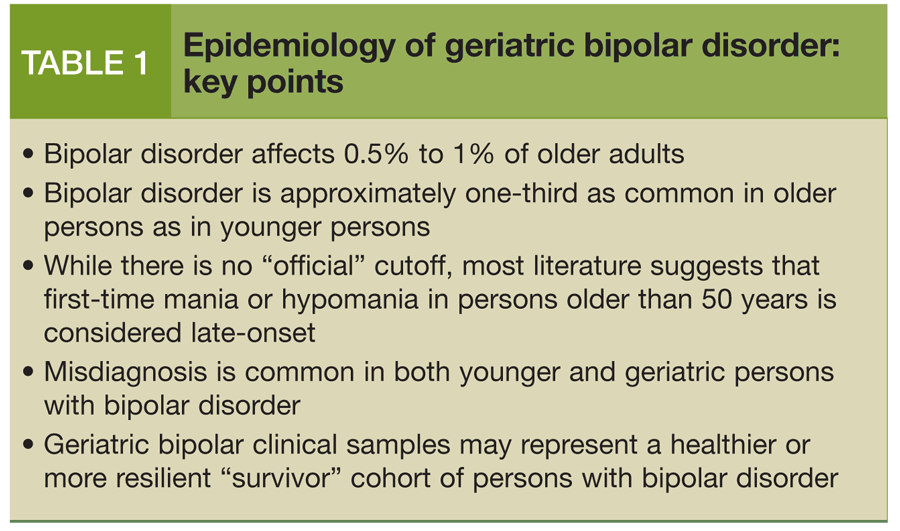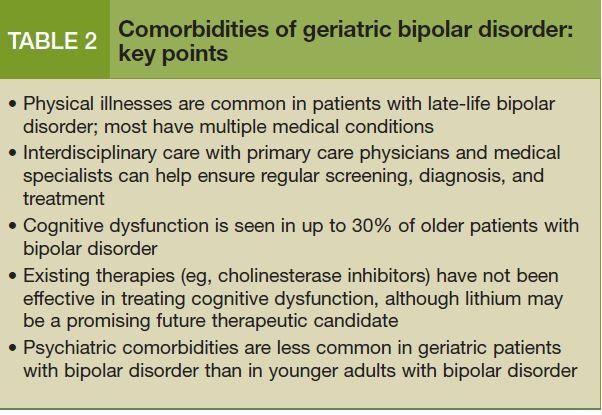Publication
Article
Psychiatric Times
Managing Late-Life Bipolar Disorder: Current Issues and Clinical Tips
Author(s):
Key issues about geriatric bipolar disorder-epidemiology, assessment, medical and psychiatric comorbidity, and treatment-are the focus.
Table 1

Table 2

The world’s elderly population is growing at an unprecedented pace, and it is expected that within the next 50 years the number of individuals aged 60 or older will triple.1 The health care community has to prepare for sharply ramped-up service needs for older adults, including those with chronic mental conditions, such as bipolar disorder (BD). Elderly patients may represent up to 25% of the population with BD.2 This article provides an overview of key issues relevant to geriatric BD, including epidemiology, assessment, medical and psychiatric comorbidity, and treatment.
Epidemiology
Epidemiologic studies suggest that 0.5% to 1% of elderly people have type I or II BD.3-5Table 1 summarizes the key epidemiologic points on BD in elderly patients. Similar to what is seen in late-life schizophrenia, BD in the geriatric population is only one-third as common as in younger populations.6 In both younger and geriatric persons, BD may be misdiagnosed or underdetected.
Older patients with BD are a group with variable evolutionary pathways. The great majority of elderly persons with BD have illness onset in early adulthood and have aged with BD. A smaller subgroup, 5% to 10%, are aged 50 or older at the time of a first definitive manic or hypomanic episode.3 While there is no “official” cutoff, it is agreed that age 50 is a reasonable defining threshold for lateonset BD.7 Since there are higher rates of familial transmission in early-onset cases and late-onset cases are usually more associated with neurological comorbidity, it is possible that early-onset BD and the lateonset variant are different illnesses. Clinical presentation and course of illness in later life also vary. Older patients may have more severe depressive episodes and less severe manic episodes than younger patients.
The epidemiology and clinical presentation of geriatric BD must be interpreted cautiously, since most study samples are cross-sectional and are probably survivor cohorts. The individuals in these samples may be healthier or more resilient than the general population of people with BD. Longitudinal analyses that include mortality data are needed to arrive at a more definitive understanding of course and presentation of BD across the life span.
Assessment and differential diagnosis
Recognition and accurate diagnosis of late-life BD can be challenging. Assessment of mood symptoms in elderly patients should start with a careful history taken from the patient and collaborative sources. Evaluation should focus on mood, anxiety, and cognitive and neuropsychiatric symptoms as well as on assessment for comorbidities, use of new medications or herbal/alternative supplements, and adherence to prescribed medications.
Related content:
Pop Quiz: Disturbances, Disorientation, and Delirium
The differential diagnosis of acute mania is often complicated by comorbidities, such as medical illness. It is therefore important to differentiate between idiopathic late-onset BD and secondary mania due to medical causes. Several medical conditions have been associated with mania, including CNS disorders (vascular dementia, encephalitis, neurosyphilis, HIV encephalopathy, strokes, Huntington disease, multiple sclerosis, traumatic brain injury), tumors (right temporal lobe, orbitofrontal, hypothalamic), and systemic diseases (systemic lupus erythematosus, hyperthyroidism, vitamin B12 deficiency). Substances that can induce mania include stimulants, cocaine, sympathomimetics, corticosteroids, TCAs, thyroid replacement therapies, hydralazine, and levodopa.
Mania in the elderly should also be differentiated from delirium or dementia. Sudden cognitive disturbances, disorientation, and cloudiness of consciousness are more suggestive of delirium than mania. Impulsivity, disinhibition, and irritability are more common in moderate and severe dementia but could also be related to underlying mood symptoms. Familiarity with the typical symptom patterns of individual patients, the chronology of presenting symptoms supported by physical and neurological examination, and laboratory and imaging investigations can help clarify the presenting picture and guide treatment.
Laboratory tests and imaging studies can help rule out mania due to medical causes. A recommended basic workup typically includes a complete blood cell count; electrolytes profile; liver, kidney, and thyroid function tests; vitamin B12 and folate levels; urinalysis; urine drug screen; and ECG. The clinical picture and relevant differential diagnosis should dictate the need for other assessments. Imaging studies (head CT or MRI) are indicated in all cases of new-onset mania to rule out vascular and other intracranial pathology. If the clinical presentation is suggestive of brain neoplasm, encephalitis, multiple sclerosis, or vasculitis, a brain MRI scan is preferred.
Medical, cognitive, and psychiatric comorbidity
Table 2 summarizes key points about comorbidity in geriatric BD. Physical illnesses are common in the elderly, with an average of 3 or 4 medical conditions. This population is particularly vulnerable to metabolic syndrome (up to 50%), hypertension (45% to 69%), diabetes mellitus (18% to 31%), and cardiovascular disease (9% to 49%).8 Cardiovascular comorbidity partially explains the increased rates of cerebrovascular disease in late-life BD, and vascular events may be etiologically involved in late-onset BD. Cardiovascular and other medical conditions probably arise from a combination of factors, including biological stressors inherent to BD (eg, inflammation, oxidative stress), lifestyle (eg, dietary habits, physical activity, substance use), and psychotropic medication exposure (eg, antipsychotics, mood stabilizers).
Although patients with BD die on average 10 years earlier than persons in the general population because of medical comorbidities, rates of medical comorbidity may not be higher in late-life BD patients than in geriatric controls.9 As noted earlier, geriatric BD studies should be interpreted cautiously because they may represent a comparatively healthy survivor cohort. Given the high prevalence of medical comorbidity in late-life BD, it is important to regularly monitor for medical adverse effects and levels of psychotropic drugs such as lithium, valproate, and carbamazepine. Medications can reach toxic levels because of declining renal and hepatic functioning with aging and medical comorbidity and because of drug interactions (eg, use of diuretics and lithium).
Related content:
5 Key Issues About Comorbidity in Geriatric Bipolar Disorder
Cognitive dysfunction affects many older BD patients, and it is often associated with functional disability. Although impairment exists in multiple domains, including attention, executive function, processing speed, working memory, and verbal memory, it is unclear whether dysfunction is comparatively more severe in older BD patients. As with medical comorbidity, cognitive dysfunction has a number of causes in BD, including inflammatory and oxidative processes. Medications with higher anticholinergic burden may be a contributing factor (eg, certain antipsychotics), as may be substance use and cardiovascular disease.
Effective therapies, including cholinesterase inhibitors, have not yet been found for cognitive dysfunction in BD. Epidemiological evidence suggests that lithium users experience lower rates of dementia than do other BD patients.10 Whether lithium can treat or prevent BDrelated cognitive decline remains unclear, and further research is needed.
Psychiatric comorbidities are less common in geriatric BD patients than in younger adults with BD. The most prevalent comorbidities are substance use (up to 9% to 29%, mostly alcohol use) and anxiety disorders (up to 22%).8,11
Psychopharmacology
Age-specific treatment guidelines are lacking. Other than an ongoing large-scale randomized controlled trial (RCT) that has not yet been published, no large-scale prospective study has been conducted in geriatric BD patients. The current literature consists largely of uncontrolled, retrospective, open-label, or secondary analysis of large mixed-age population studies with a wide range of reported outcomes.
Clinicians could start by using treatments with both RCT evidence in adults and some data in older adults, followed by medication with evidence of fewer risks. Conclusions and treatment recommendations based on the extant literature must be tempered with the consideration that all are based on suboptimal data sources.
Treatment of late-life bipolar depression. Lithium, lamotrigine, quetiapine, lurasidone, and some mood stabilizer/antidepressant combinations may be helpful in bipolar depression, but geriatric-specific data on their use are limited. A few small studies reported efficacy of lithium and valproate in later-life bipolar depression-lamotrigine and adjunctive aripiprazole may also be helpful.12-14 Electroconvulsive therapy (ECT) is well tolerated and effective in the elderly, and findings indicate that it is an effective treatment for bipolar depression.15,16 Other neurostimulation techniques, such as transcranial magnetic stimulation, may potentially be useful, but more research in geriatric patients is needed.
A treatment algorithm for geriatric bipolar depression might be to start with lithium or lamotrigine, then move to agents such as quetiapine, lurasidone, valproate, and adjunctive aripiprazole. If response to these agents is poor, ECT could be tried, with cautious surveillance for cognitive dysfunction.
Treatment of late-life bipolar mania. Lithium has long been used in acute mania. Delirium, cognitive impairment, ataxia, tremors, renal dysfunction, hypothyroidism, rash, weight gain, and peripheral edema have been reported with use of lithium in geriatric patients.17 Concerns about tolerability and drug-drug interactions (eg, with diuretics, angiotensin-converting enzyme inhibitors, NSAIDs) and the availability of other treatment options have contributed to fewer lithium prescriptions for the elderly.18 However, up to 40% of patients have been found to primarily respond to lithium.19 Moreover, lithium discontinuation was responsible for symptomatic mood relapse in 50% of geriatric responders.20 With regular laboratory monitoring (serum levels less than 0.8 mmol/L, and lower if possible) and clinical neurotoxicity assessment, lithium can often be safely used in older adults.
Divalproex has also been used for acute mania in older adults.21 GI problems, sedation, weight gain, and metabolic syndrome are the most common adverse effects.22 Rare adverse effects include thrombocytopenia, pancreatitis, fatal hepatotoxicity, and encephalopathy.23 Aspirin, digoxin, warfarin, phenytoin, and lamotrigine affect divalproex clearance.
Although many atypical antipsychotics have RCT evidence for mania, the data for geriatric use are limited. Quetiapine data pooled from RCTs in adults showed efficacy.24 A small uncontrolled trial of asenapine also showed efficacy in the older adult population.25 The benefits of antipsychotics need to be carefully weighed with the potential risks, including weight gain, metabolic syndrome, QTc prolongation, somnolence, and extrapyramidal symptoms.
Lithium, valproate, and quetiapine could be considered as initial choices in late-life mania. Given that depression may be especially burdensome in late-life BD, agents that are potentially helpful for both mania and depression may also be preferred, such as lurasidone and aripiprazole.26,27
Maintenance treatment. There are few geriatric-specific data for preventing mood relapse in geriatric BD. Lamotrigine and lithium may be best at preventing depression and mania, respectively, while secondary analysis of a large NIH study showed that 80% of elderly patients recovered with a stepped-care pharmacotherapy approach.2,28 While patients on average took 2.05 psychoactive medications, 42% of those who achieved symptomatic remission were receiving lithium monotherapy.
Lithium monotherapy can be recommended for late-life BD maintenance for individuals who are able to tolerate lithium. For those who are unable to tolerate or who do not respond to lithium, lamotrigine, valproate, and quetiapine can be considered. Lurasidone and aripiprazole may also be helpful in preventing mania and/or depression, although more data on geriatric maintenance are needed. The use of adjunctive antidepressants is controversial, although older adults with depression may be less prone to manic switching.
Psychosocial interventions
Although cognitive-behavioral therapy, interpersonal therapy, social rhythm therapy, and psychoeducation can be useful adjuncts in BD, there is almost no literature regarding psychosocial interventions in late-life BD. While some older patients with BD could improve with behavioral interventions promoting treatment adherence, more research is necessary.
Conclusions
Despite the rapidly growing elderly population, there is limited evidence to guide treatment of geriatric patients with BD. Existing data suggest that standard medications may be useful; lower doses are preferred, and clinicians need to consider and manage multiple medical and cognitive comorbidities.
Disclosures:
Dr Rej is Geriatric Psychiatry Fellow at the University of Toronto, and Lead of the JGH Geri-PARTy Research Group at the Jewish General Hospital in Montreal. Dr Al Jurdi is Deputy Executive at the Mental Health Care Line at the Michael E. DeBakey Veterans Affairs Medical Center and Associate Professor in the Menninger Department of Psychiatry and Behavioral Sciences at the Baylor College of Medicine in Houston. Dr Sajatovic is Professor of Psychiatry and of Neurology at the Case Western Reserve University School of Medicine, University Hospitals Case Medical Center in Cleveland. Drs Rej and Al Jurdi report no conflicts of interest concerning the subject matter of this article. Dr Sajatovic reports that she has received research grants from the CDC, Janssen, Merck, Ortho-McNeil-Janssen, the NIH, Pfizer, Reinberger Foundation, Reuter Foundation, and Woodruff Foundation; she is a consultant for Amgen, Bracket, Otsuka, Pfizer, ProPhase; she receives royalties from Johns Hopkins University Press, Oxford Press, Springer Press, UpToDate, Lexicomp; and she has consulted on CME activities for the American Physician Institute and MCM Education.
References:
1. World Population Ageing: 1950-2050. http://www.un.org/esa/population/publications/worldageing19502050/pdf/80chapterii.pdf. Accessed August 27, 2014.
2. Sajatovic M, Gyulai L, Calabrese JR, et al. Maintenance treatment outcomes in older patients with bipolar I disorder. Am J Geriatr Psychiatry. 2005;13:305-311.
3. Hirschfeld RM, Lewis L, Vornik LA. Perceptions and impact of bipolar disorder: how far have we really come? Results of the national depressive and manic-depressive association 2000 survey of individuals with bipolar disorder. J Clin Psychiatry. 2003;64:161-174.
4. Kessler RC, Berglund P, Demler O, et al. Lifetime prevalence and age-of-onset distributions of DSM-IV disorders in the National Comorbidity Survey Replication [published correction appears in Arch Gen Psychiatry. 2005;62:768]. Arch Gen Psychiatry. 2005;62:593-602.
5. Unützer J, Simon G, Pabiniak C, et al. The treated prevalence of bipolar disorder in a large staff-model HMO. Psychiatr Serv. 1998;49:1072-1078.
6. Depp CA, Jeste DV. Bipolar disorder in older adults: a critical review. Bipolar Disord. 2004;6:343-367.
7. Sajatovic M, Kessing LV. Bipolar disorder in the elderly. In: Yatham LN, Maj M, eds. Bipolar Disorder: Clinical and Neurobiological Foundations. West Sussex, UK: John Wiley & Sons, Inc; 2010.
8. Lala SV, Sajatovic M. Medical and psychiatric comorbidities among elderly individuals with bipolar disorder: a literature review. J Geriatr Psychiatry Neurol. 2012;25:20-25.
9. Westman J, Hällgren J, Wahlbeck K, et al. Cardiovascular mortality in bipolar disorder: a population-based cohort study in Sweden. BMJ Open. 2013;3:e002373.
10. Mauer S, Vergne D, Ghaemi SN. Standard and trace-dose lithium: a systematic review of dementia prevention and other behavioral benefits. Aust N Z J Psychiatry. 2014;48:809-818.
11. Dols A, Rhebergen D, Beekman A, et al. Psychiatric and medical comorbidities: results from a bipolar elderly cohort study. Am J Geriatr Psychiatry. 2014 Jan 4; [Epub ahead of print].
12. McFarland BH, Miller MR, Straumfjord AA. Valproate use in the older manic patient. J Clin Psychiatry. 1990;51:479-481.
13. Sajatovic M, Gildengers A, Al Jurdi RK, et al. Multisite, open-label, prospective trial of lamotrigine for geriatric bipolar depression: a preliminary report [published correction appears in Bipolar Disord. 2011;13:581]. Bipolar Disord. 2011;13:294-302.
14. Sajatovic M, Coconcea N, Ignacio RV, et al. Aripiprazole therapy in 20 older adults with bipolar disorder: a 12-week, open-label trial. J Clin Psychiatry. 2008;69:41-46.
15. Hausner L, Damian M, Sartorius A, Frölich L. Efficacy and cognitive side effects of electroconvulsive therapy (ECT) in depressed elderly inpatients with coexisting mild cognitive impairment or dementia. J Clin Psychiatry. 2011;72:91-97.
16. Sackeim HA, Prudic J. Length of the ECT course in bipolar and unipolar depression. J ECT. 2005;21:195-197.
17. Young RC, Schulberg HC, Gildengers AG, et al. Conceptual and methodological issues in designing a randomized, controlled treatment trial for geriatric bipolar disorder: GERI-BD. Bipolar Disord. 2010;12:56-67.
18. Shulman KI, Rochon P, Sykora K, et al. Changing prescription patterns for lithium and valproic acid in old age: shifting practice without evidence. BMJ. 2003;326:960-961.
19. Grof P. Sixty years of lithium responders. Neuropsychobiology. 2010;62:8-16.
20. Fahy S, Lawlor BA. Discontinuation of lithium augmentation in an elderly cohort. Int J Geriatr Psychiatry. 2001;16:1004-1009.
21. Goldberg JF, Sacks MH, Kocsis JH. Low-dose lithium augmentation of divalproex in geriatric mania. J Clin Psychiatry. 2000;61:304.
22. Fuller M, Sajatovic M. Drug Information Handbook for Mental Health. Cleveland: Lexi-Comp, Inc; 2000.
23. Bowden CL. Lamotrigine in the treatment of bipolar disorder [published correction appears in Expert Opin Pharmacother. 2002;3:1683]. Expert Opin Pharmacother. 2002;3:1513-1519.
24. Sajatovic M, Calabrese JR, Mullen J. Quetiapine for the treatment of bipolar mania in older adults. Bipolar Disord. 2008;10:662-671.
25. Yatham LN, Kennedy SH, Parikh SV, et al. Canadian Network for Mood and Anxiety Treatments (CANMAT) and International Society for Bipolar Disorders (ISBD) collaborative update of CANMAT guidelines for the management of patients with bipolar disorder: update 2013. Bipolar Disord. 2013;15:1-44.
26. Loebel A, Cucchiaro J, Silva R, et al. Lurasidone monotherapy in the treatment of bipolar I depression: a randomized, double-blind, placebo-controlled study. Am J Psychiatry. 2014;171:160-168.
27. Sajatovic M, Dines P, Fuentes-Casiano E, et al. Asenapine in the treatment of older adults with bipolar disorder. Int J Geriatr Psychiatry. In press.
28. Al Jurdi RK, Marangell LB, Petersen NJ, et al. Prescription patterns of psychotropic medications in elderly compared with younger participants who achieved a “recovered” status in the systematic treatment enhancement program for bipolar disorder. Am J Geriatr Psychiatry. 2008;16:922-933.
Newsletter
Receive trusted psychiatric news, expert analysis, and clinical insights — subscribe today to support your practice and your patients.






